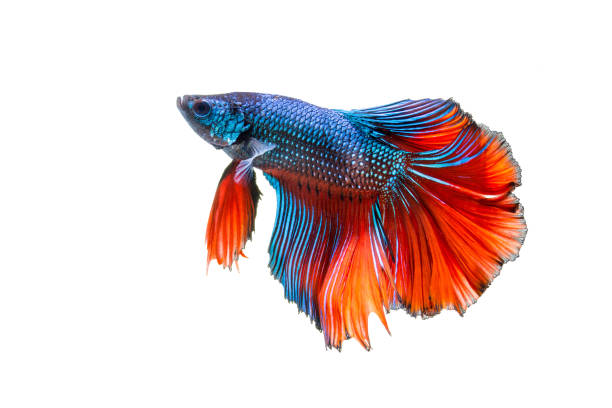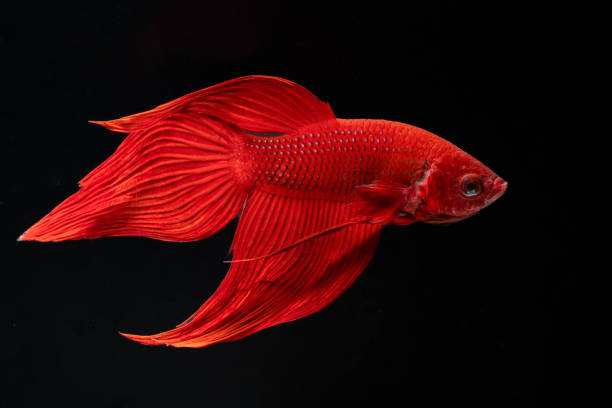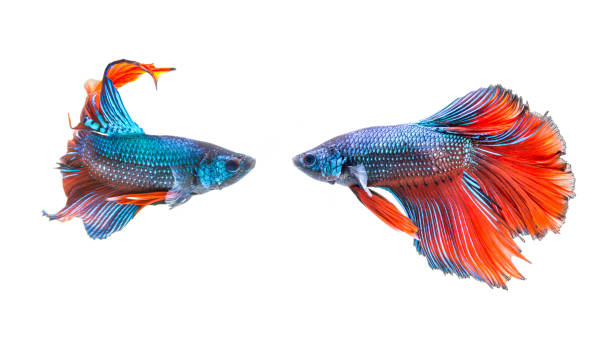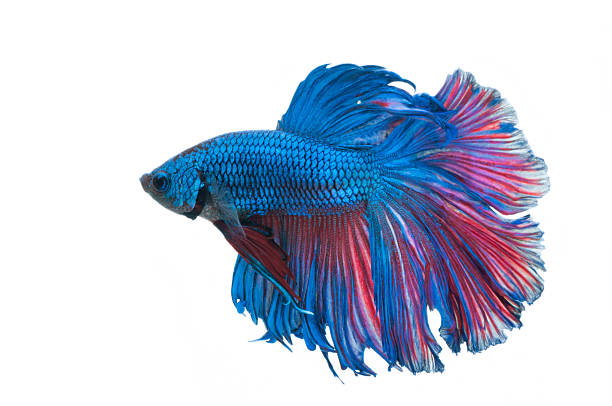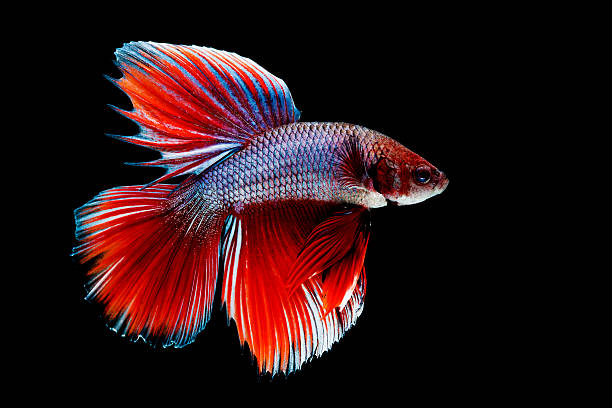
Creating the ideal environment for a betta fish is crucial to ensuring its health and longevity. Betta fish, known for their vibrant colors and flowing fins, require specific tank conditions to thrive. This comprehensive guide will walk you through the essential steps of setting up a fish tank tailored to meet your betta’s needs.
Selecting the Right Tank
When choosing a tank for your betta, size matters. Contrary to popular belief, bettas are not suited for tiny bowls or small containers. They need ample space to swim and explore.
- Recommended Size: A minimum of 5 gallons is ideal.
- Tank Shape: Rectangular tanks provide more horizontal swimming space.
- Avoidance: Small vases or bowls can cause stress and health issues.
| Tank Size | Recommended? | Reason |
| < 3 Gallons | No | Restricts movement and impacts water quality |
| 5 Gallons | Yes | Provides adequate space and easier maintenance |
| 10+ Gallons | Ideal | Optimal for enrichment and stability |
Setting Up Filtration
A proper filtration system is essential to maintain water quality while keeping the current gentle, as bettas dislike strong water flow.
- Use low-flow filters designed for smaller tanks.
- Sponge filters are an excellent choice due to their gentle circulation.
- Perform regular filter maintenance to prevent clogging.
Heating the Tank
Betta fish are tropical creatures that thrive in warm water temperatures between 76°F and 82°F (24°C – 28°C). Inconsistent or low temperatures can weaken their immune system.
- Install an adjustable aquarium heater with a built-in thermostat.
- Use an aquarium thermometer to monitor temperature consistently.
- Avoid placing the tank near windows or vents where temperature fluctuations occur.
Substrate Selection
- Gravel: A popular option that’s easy to clean but can trap waste if not maintained properly.
- Sand: Provides a softer texture, better resembling natural environments.
- Aquarium Soil: Ideal if you plan on adding live plants as it promotes healthy root growth.
Adding Plants and Decorations
- Java Fern
- Anubias
- Marimo Moss Balls
- Opt for silk plants instead of plastic ones as sharp edges can damage the fins.
- Caves or hollow decorations provide hiding spots.
- Floating logs mimic natural surfaces where bettas like to rest.
Ensure decorations have no rough edges that could tear the delicate fins of your fish.
Water Preparation
- Dechlorinate tap water using an appropriate water conditioner.
- Test pH levels—bettas prefer slightly acidic to neutral conditions (pH between 6.5 – 7.5).
- Allow the tank to cycle completely (a process taking approximately two weeks) before adding fish.
Lighting Requirements
- Use LED aquarium lighting with adjustable brightness levels.
- Set up a timer for approximately 8–10 hours of light per day, mimicking natural daylight cycles.
Setting up a suitable tank is one of the most important aspects of caring for your betta fish properly. With careful attention to these details, you’ll create an environment where your pet can flourish physically and behaviorally over time while showcasing its natural beauty at its fullest potential.
Discover Stunning Betta Fish Colors and Patterns at Our Betta Fish Online Shop
Betta fish, also known as Siamese fighting fish, are renowned for their vibrant colors and intricate patterns that captivate aquarists worldwide. These striking features are a result of selective breeding and genetic variations, making each Betta unique in its appearance. Understanding these colors and patterns not only enhances your appreciation for these beautiful fish but also helps in identifying their health and well-being.
How Betta Fish Get Their Colors
The dazzling colors of Betta fish stem from specialized cells in their skin called chromatophores. Chromatophores contain pigments, which interact with light to produce various hues. There are three key types of chromatophores involved in Betta coloration: – Melanophores: Responsible for black or dark shades. – Erythrophores: Produce red, orange, or yellow pigments. – Iridophores: Reflect light to create iridescent blues, greens, or metallic sheens.
Through selective breeding, aquarists have enhanced the expression of these chromatophores to develop the stunning color combinations we see today.
Common Color Variations in Betta Fish
| Color Type | Description |
| Solid | A single color covers the entire body and fins (e.g., all blue or all red). |
| Bi-color | The body is one color while the fins display a contrasting hue. |
| Marble | Irregular patches of different colors across the body and fins. |
| Butterfly | Fins have bands of two or more distinct colors, often with a clear division. |
| Metallic | Scales exhibit a shiny or iridescent appearance due to enhanced iridophores. |
Understanding Betta Patterns
Aside from their diverse colors, Betta fish exhibit fascinating patterns that add further complexity to their visual appeal: 1. Dragon Scale: Thick scales resembling armor with bold metallic hues. 2. Koi Pattern: Resembling Koi fish with marbled patches resembling splotches of paint. 3. Wild Patterning: Mimics the natural coloration found in wild species—subtle yet elegant.
These patterns can change over time due to environmental factors such as lighting and water quality or during specific life stages.
Factors Influencing Color Intensity
The vibrancy of your Betta’s color can be influenced by several factors: – Diet: High-quality foods rich in carotenoids can enhance red and orange hues. – Lighting: Proper aquarium lighting can highlight iridescent tones. – Stress Levels: Stress may dull a Betta’s color; maintaining optimal tank conditions reduces stress. – Genetics: Some Bettas naturally display more vivid coloration than others due to genetic lineage.
Why Coloration Matters Beyond Aesthetics
The brilliance of your Betta’s color can serve as an indicator of its overall health: – Bright and vibrant colors typically signify good health. – Fading or dulling could indicate stress, illness, or suboptimal water conditions.
By understanding what makes Bettas so uniquely colorful and patterned, hobbyists can better care for these remarkable creatures while enjoying their beauty fully.
Discover Where to Buy Betta Fish for Sale in Stunning Colors and Patterns
Betta fish, often referred to as Siamese fighting fish, are renowned for their stunning array of colors and intricate patterns. These vibrant creatures have captivated aquarists for decades, partly due to their striking beauty. This section explores the fascinating world of Betta fish colors and patterns, shedding light on the genetic factors and selective breeding processes that make them such a visual delight.
Understanding Betta Fish Colors
- Erythrophores: Pigments responsible for red tones.
- Iridophores: Reflective cells that produce iridescent blues and greens.
- Melanophores: Producing black or dark coloration.
Through generations of selective breeding, breeders have accentuated these pigments, giving rise to a wide variety of bright hues, including rare colors like purple or metallic shades.
Popular Color Variations
- Solid Colors: Shades like red, blue, black, or white dominate the entire body without interruption.
- Bi-Colored Bettas: Feature one color on the body and another on the fins.
- Marble Patterns: Characterized by random spots or splotches across their bodies; they often change over time due to genetic instability.
- Butterfly Bettas: Have fins with distinct bands of different colors resembling butterfly wings.
- Koi Bettas: Mimic the patterns seen in koi fish with asymmetrical patches resembling paint splatters.
| Color Type | Description |
| Solid | Single uniform color across body and fins |
| Bi-Colored | Body is one shade; fins are another |
| Marble | Splotchy patterns; tends to shift over time |
| Butterfly | Multicolored fins with clear banding |
| Metallic | Shimmery scales creating an iridescent effect |
Intricate Patterns Found in Bettas
- Dragon Scale Pattern
Features thick, metallic-like scales resembling armor plates. Often paired with vibrant base colors for extra contrast. - Cambodian Pattern
A lighter-colored body (often white) combined with deep-hued fins like red or blue. - Cellophane Pattern
Almost transparent body and fins with light pigmentation. - Multicolor Patterns
Display three or more distinct shades across both the body and fins—a true testament to genetic diversity.
The Role of Genetics in Coloration
- Breeders may pair specific traits (e.g., iridescence or rarity) for vibrant outcomes.
- Some rare colors—such as white opaque or true purple—are highly sought after due to their recessive nature requiring precise pairings.
Selective breeding has also led to new innovations such as “Galaxy” bettas featuring sparkling iridescence akin to stars scattered across a night sky.
Betta fish are truly living works of art brought about by a combination of natural beauty and human craftsmanship through thoughtful breeding efforts. Whether you prefer a solid-colored classic look or an intricate marble pattern that evolves over time, there’s no denying that each betta is unique—a reason they remain ever-popular among aquarium enthusiasts worldwide.
Betta Fish Behavior: Understanding Their Unique Personalities
Betta fish, also known as Siamese fighting fish, are beloved for their stunning appearance and distinctive personalities. Understanding their behavior is essential to ensure their well-being and foster a strong bond with these fascinating creatures. Below is a guide to help identify and interpret the unique characteristics of your betta fish’s behavior.
Natural Betta Behaviors
- Flaring: Betta fish flare their gills and spread out their fins, often as a display of dominance or territoriality. This is typically observed in the presence of another betta or when they see their own reflection.
- Bubble Nesting: Male bettas blow clusters of bubbles on the surface of the water as part of their reproductive behavior. This indicates they are comfortable in their environment.
- Swimming Patterns: Betta fish may swim gracefully across the tank, hover near plants, or patrol specific areas. Balanced swimming indicates that your betta is healthy.
- Resting on Surfaces: Bettas often rest on leaves, tank ornaments, or at the bottom of the tank. This is normal if done intermittently.
Signs of Stress in Betta Fish
| Behavior | Possible Cause | Suggested Action |
| Hiding excessively | Poor water quality or stress | Test and improve water parameters |
| Clamped fins (fins held close to body) | Temperature instability | Ensure proper tank temperature (75–80°F) |
| Lethargy or lack of activity | Inadequate space or illness | Check for illnesses; upgrade tank size |
| Aggressive flaring at reflection | Glass reflection causing agitation | Reduce external lighting; provide cover |
Interpreting Personality Traits
- Shy Bettas: Provide plenty of hiding spots with plants or decorations.
- Active Bettas: Offer stimulation through toys like floating mirrors (used sparingly), leaf hammocks, or gentle water currents.
- Curious Bettas: These tend to interact with new objects in their tank. Rotate decorations occasionally to maintain engagement.
Key Factors That Influence Behavior
- A small bowl restricts movement and may lead to lethargy or stress.
- A minimum 5-gallon tank supports healthy exploration.
- High ammonia levels can cause erratic swimming or frequent surface gasping.
- Perform weekly partial water changes and invest in a reliable filter.
- Choose companions carefully if you plan on keeping other species with your betta.
- Avoid placing two male bettas together due to aggression.
- Maintain consistent light schedules (8–12 hours per day) as irregular lighting can confuse your fish’s natural rhythm.
By understanding your betta’s unique behaviors, you’ll not only create a more enjoyable environment but also build trust with them over time—making this colorful companion even more delightful to care for.
The Complete Guide to Choosing the Right Betta Fish for Your Aquarium
Selecting the right betta fish for your aquarium involves more than simply picking the most colorful or vibrant one. With so many varieties available, making an informed decision is essential for both you and the fish’s well-being. This guide will walk you through important factors to consider when choosing a betta fish, helping you find the perfect match for your tank and lifestyle.
1. Understand Betta Varieties
Betta fish come in numerous colors, patterns, and tail types. Familiarizing yourself with these varieties can help narrow down your options.
- Veil Tail: Long, flowing fins; one of the most common types.
- Crown Tail: Fins have spiky extensions resembling a crown.
- Halfmoon: A semi-circular tail spread resembling a half-moon.
- Plakat: Short-finned variety closer to wild bettas; easier to maintain.
- Color Variations: Betta fish are available in nearly every color imaginable. Some popular options include:
- Solid colors like blue, red, or white.
- Multi-colored combinations or marbled patterns.
- Unique options like metallic or iridescent hues.
- Patterns: Patterns range from solid and bi-color to more complex designs like butterfly (contrasting bands of colors on fins) or koi (resembling koi fish patterns).
| Tail Type | Characteristics | Maintenance Level |
| Veil Tail | Flowing fins; beginner-friendly | Moderate |
| Crown Tail | Spiky fin extensions | Slightly higher care needed |
| Halfmoon | Large semi-circle tail | Requires careful handling |
| Plakat | Shorter fins; hardy | Easiest to maintain |
2. Assess Your Tank Size and Setup
- Tank Size: Bettas require at least five gallons of water per individual. Avoid small bowls or cramped spaces that limit their movement and quality of life.
- Temperature: Maintain water between 76°F and 80°F using an aquarium heater.
- pH Level: Bettas prefer a pH range of 1.1–1.1, which mimics their natural habitat.
If you have already established other aquatic species in your tank, research compatibility since bettas can be territorial around certain species.
3. Consider Gender Differences
- Male bettas are known for their vivid colors and elaborate fins but tend to be more aggressive toward other males or fin-nipping species.
- Female bettas are less flashy but more social if kept in groups (sororities). However, even female sororities require monitoring for signs of aggression.
4. Inspect Health Signs Before Purchase
- Look for active swimming behavior without sluggishness or excessive hiding.
- Check that scales appear smooth without discoloration or raised areas (which could indicate disease).
- Fins should be intact with no visible tears, clamping, or fraying edges.
Spending extra time observing potential purchases helps reduce the risk of introducing illness into your aquarium.
Final Thoughts on Selection
Choosing the right betta requires careful planning based on type preferences, tank conditions, gender dynamics, and health assessments. By taking these factors into account before bringing home a new pet, you not only enhance the visual appeal of your aquarium but also ensure the long-term happiness of your aquatic companion.
Exploring the Origins and History of Betta Fish Species
Betta fish, also known as Betta splendens or Siamese fighting fish, hold an intriguing place in aquatic history. Loved for their vibrant colors, flowing fins, and spirited behavior, these fish have been cherished by hobbyists around the globe. Understanding their origins provides valuable insight into their nature and care requirements.
Native Habitat and Geographic Origin
Betta fish are native to Southeast Asia, thriving in shallow waters such as rice paddies, slow-moving streams, and floodplains. Countries like Thailand, Cambodia, Vietnam, and Malaysia are home to wild bettas. Their natural environments are often murky with low oxygen levels—conditions that influenced the development of their unique labyrinth organ.
The labyrinth organ allows bettas to gulp air directly from the surface when oxygen levels in water are insufficient. This adaptation enables them to survive in harsh environments where other species may struggle.
Historical Significance in Thai Culture
The history of betta fish is deeply rooted in Thai culture. Before they became ornamental pets, wild bettas were collected for a different purpose: fighting competitions. Male bettas were prized for their aggression and territorial instincts. The combats were non-lethal but intense displays of dominance.
Records suggest that selective breeding of bettas for fighting traits began over 150 years ago in Thailand (formerly Siam). This practice eventually led King Rama III to gift domesticated bettas to European visitors during the 19th century—marking the beginning of global fascination with these vibrant creatures.
Evolution Through Selective Breeding
- Tail Types: Crown tails, veil tails, halfmoons, double tails.
- Colors: Blues, reds, metallics (copper or gold), iridescent greens.
- Patterns: Marble (splotchy coloration), butterfly (distinct banded colors on fins), dragon scale (thick metallic scaling).
Wild-type bettas display muted shades compared to their domesticated counterparts’ vivid hues. Selective breeding has not only enhanced appearance but also altered behavior; modern pet-store varieties tend to be less aggressive than their ancestors bred strictly for combat.
Conservation Concerns Regarding Wild Betta Species
While domesticated Betta splendens flourish globally as pets, their wild relatives face environmental pressures such as habitat destruction caused by agriculture and urbanization. Currently:
| Wild Betta Species | Conservation Status |
| Betta macrostoma | Endangered |
| Betta imbellis | Vulnerable |
| Betta smaragdina | Near Threatened |
Efforts are underway among conservationists and hobbyist groups alike to preserve biodiversity within wild populations through habitat protection and ethical breeding programs.
Cultural Legacy Today
Betta fish remain a cultural icon in Thailand—they are recognized as the national aquatic animal since 2019. Globally appreciated as both pets and artistic expressions of nature’s beauty through selective breeding efforts, they serve as a reminder of how human interaction can shape species over time while highlighting our responsibility toward conservation efforts.
How to Buy Betta Fish Online and Create a Stimulating Environment for Them
Creating a stimulating environment for your betta fish is essential to their overall health and well-being. Betta fish are intelligent, curious creatures that thrive in environments that encourage activity, exploration, and enrichment. Below is a guide to help you design an engaging habitat for your betta.
1. Choosing the Right Tank Size
Betta fish need space to swim and explore. While they are often sold in small containers, this is not suitable for long-term care. Consider the following when selecting a tank: – Minimum Tank Size: 5 gallons is recommended as the minimum size. – Larger Tanks: If possible, select a larger tank (10 gallons or more) to give your betta more room to move around.
A larger tank also helps maintain water quality, which reduces stress on your fish.
2. Add Plants and Decorations
Adding plants and decorations not only enhances visual appeal but also provides stimulation: – Live Plants: Options like Java fern, Anubias, or Marimo moss balls are great choices because they mimic natural environments. – Artificial Plants: If using artificial plants, ensure they have soft edges to avoid damaging your betta’s fins. – Hiding Spots: Include caves, tunnels, or ornaments with openings where your betta can retreat when needed.
Having plenty of hiding spaces helps reduce stress and allows your betta to feel secure.
3. Incorporate Gentle Filtration and Proper Lighting
Bettas thrive in clean but low-flow water conditions: – Use a gentle filter that doesn’t create strong currents; sponge filters work well. – Provide adequate lighting on a set schedule (8–12 hours per day) to replicate day-night cycles without overexposure.
Proper lighting can also enhance plant growth if you use live plants.
4. Maintain Ideal Water Conditions
Betta fish require specific water parameters for optimal health: | Parameter | Ideal Range | |———————|——————-| | Temperature | 76–82°F (24–28°C) | | pH Level | 6.5–7.5 | | Ammonia/Nitrite | 0 ppm | | Nitrate | <20 ppm |
Use an aquarium heater to maintain consistent water temperatures and test the water regularly with an aquarium test kit.
5. Introduce Enrichment Activities
Bettas are intelligent fish that benefit from mental stimulation through activities such as: – Floating Toys: Ping pong balls or floating rings can encourage play behavior. – Training & Interaction: Bettas can learn simple tricks like swimming through hoops or following your finger along the glass. – Feeding Games: Offer food in different areas of the tank or use feeding tools like tweezers to stimulate their hunting instincts.
Avoid overfeeding while engaging in these activities; bettas have small stomachs and can become bloated easily.
6. Avoid Overcrowding
Bettas are territorial by nature and generally prefer solitude: – Avoid housing male bettas together as it may lead to aggression. – If considering other tankmates (e.g., snails or peaceful species), research compatibility thoroughly beforehand.
Providing ample space ensures harmony within the environment while reducing stress levels.
By thoughtfully designing a stimulating habitat catered specifically for their needs, you significantly improve both the physical health and mental well-being of your betta fish.
How to Create a Stimulating Environment for Your Betta Fish
Betta fish, also known as Siamese fighting fish, are intelligent and active creatures that thrive in an enriching environment. Providing them with a stimulating habitat not only supports their physical health but also enhances their mental well-being. Below is a guide on how to create an engaging space for your betta fish to ensure they live a healthy and fulfilling life.
Tank Size and Setup
- Tank Size: A common misconception is that bettas can thrive in small bowls. However, they require at least a 5-gallon tank to swim freely and exercise.
- Filtration: A gentle filtration system is essential to maintain water quality without creating strong currents that might stress your betta.
- Heater: Bettas are tropical fish and need water temperatures between 76°F and 82°F (24°C – 28°C). A reliable heater will help maintain this range consistently.
- Water Quality: Use a water conditioner to remove chlorine and other harmful chemicals from tap water. Regular water changes (25%-30% weekly) are essential for maintaining cleanliness.
Decorations and Hiding Spots
- Live or Silk Plants: Live plants such as Java Fern or Anubias provide natural cover while also improving water quality by absorbing nitrates. Silk plants are another safe alternative if live plants aren’t an option.
- Hiding Spaces: Add caves, hollow logs, or coconut shells where your betta can retreat when they want privacy.
- Floating Objects: Bettas love resting near the surface of the water. Floating decorations or plants like Indian almond leaves can provide great resting areas.
Enrichment Through Toys and Activities
Bettas are curious creatures that benefit from mental stimulation through toys and interactive elements within their tanks.
Recommended Enrichment Ideas:
- Betta Mirrors: These allow your betta to flare temporarily, mimicking social interactions without introducing actual tank mates.
- Ping Pong Balls: A floating ping pong ball can keep your betta engaged as they push it around the surface.
- Leaf Hammocks: These allow your betta to rest near the surface comfortably.
- Bubble Wands or Gentle Bubbles (optional): Some bettas enjoy soft bubbles in their tanks but monitor closely as others may find it stressful.
Lighting and Day-Night Cycle
- Provide 8–12 hours of light per day using aquarium-safe LED lights.
- Ensure periods of darkness at night so your betta can rest properly.
Avoid placing the tank in direct sunlight, as it can lead to overheating and rapid algae growth.
Monitoring Behavior
- If your betta swims actively, builds bubble nests, or interacts with enrichment items, these are signs of a happy fish.
- On the other hand, lethargy or hiding constantly may indicate stress or illness requiring adjustments in their environment.
| Feature | Recommendation | Purpose |
| Tank Size | Minimum 5 gallons | Provides ample swimming space |
| Filtration System | Gentle flow | Maintains clean water without stress |
| Temperature | 76°F–82°F | Ensures tropical habitat conditions |
| Plants | Live or silk | Adds cover & enrichment |
| Hiding Spots | Caves/Logs | Offers security & reduces stress |
With proper care and thoughtful design choices for their environment, you’ll notice how vibrant and interactive your betta becomes over time—a true testament to their happiness in a stimulating home.
- Your Ultimate Guide to Betta Fish for Sale: Tips on Finding and Understanding Pricing
- A Comprehensive Beginner’s Guide to Setting Up a Tank for Betta Fish for Sale
- Buy Betta Fish for Sale: Your Guide to Keeping Them Healthy and Thriving
- A Complete Guide on How to Buy Betta Fish Online
- Guide to Buy Betta Fish Online and Explore Their Unique Characteristics
- Your Ultimate Betta Fish Online Shop Guide: Caring for Betta Fish Made Easy
